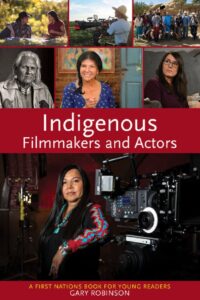Book review: Indigenous Filmmakers and Actors: A First Nations Book for Young Readers
 Reviewed by Carrie MacKenzie
Reviewed by Carrie MacKenzie
Indigenous Filmmakers and Actors: A First Nations Book for Young Readers by Gary Robinson is an uplifting and motivational non-fiction book that outlines the careers of various Indigenous individuals in the entertainment industry. It is part of The First Nations Series for Young Readers geared towards youth aged 8-13.
This book gives first-hand accounts of the lives and careers of various Indigenous storytellers. To make this relatable, both men and women are featured, including the story of a transgendered Indigenous woman. These people are from various backgrounds and take different paths to their careers. This allows readers to find something in common with those profiled, making a stronger connection.
The fact that not all of the individuals profiled are actors but those working in other areas in film and television are included making this book accessible to a wider audience. Not every reader is interested in acting; they may want to learn about other options and want insights into the industry. Within this book, they can find role models to be proud of, even if they are not interested in working in the entertainment industry. They see examples of people who look like them and have similar cultures, backgrounds, experiences and are working at careers they love.
The language used also makes this book accessible to a wider audience. It is written so that it can be understood by 8–13-year-olds; however, some words related to the entertainment industry are not common so there is a glossary in the back of the book containing the definition of these words to aid in understanding. This gives the reader even more information about a career that they might be interested in.
The tone of this book is serious but gentle with a sense of hope and respect. It addresses serious issues including the racism faced by Indigenous peoples and the misrepresentation of Indigenous people and culture on television and on the big screen. However, it does so in a sensitive way ensuring that the reader is not overwhelmed. This enables the audience to learn from what they are reading. A sense of hope and respect comes from what the profiled individuals have overcome and the changes they have achieved. Respect is shown by using the individual’s own words and talking about which First Nation they are from.
This book also lists some of the credits of the storytellers profiled. This exposes the audience to films that they may not have seen or heard of. This gives them even more information about Indigenous culture and issues faced by Indigenous peoples. Furthermore, as the films highlighted involve Indigenous people in various roles, their portrayal of Indigenous experiences and culture will be accurate and relevant. This makes the representations on-screen harder for the reader to minimize or outright dismiss.
The fact that the individual’s story is told in part using their own words strengthens the impact of their stories. It makes their experience harder if not impossible to dismiss. It also helps Indigenous readers relate to those whose stories are included as they not only see people who look like them, but have had similar experiences.
This book is an excellent resource for young readers interested in careers in the entertainment industry. It is also a helpful resource for those who want to watch shows and films about the Indigenous experience that are accurate in their depictions due to the involvement of Indigenous storytellers.
Gary Robinson, Indigenous Filmmakers and Actors: A first Nations book for Young Readers. (Toronto: Second Story Press, 2021).
ISBN: 9781772601725


